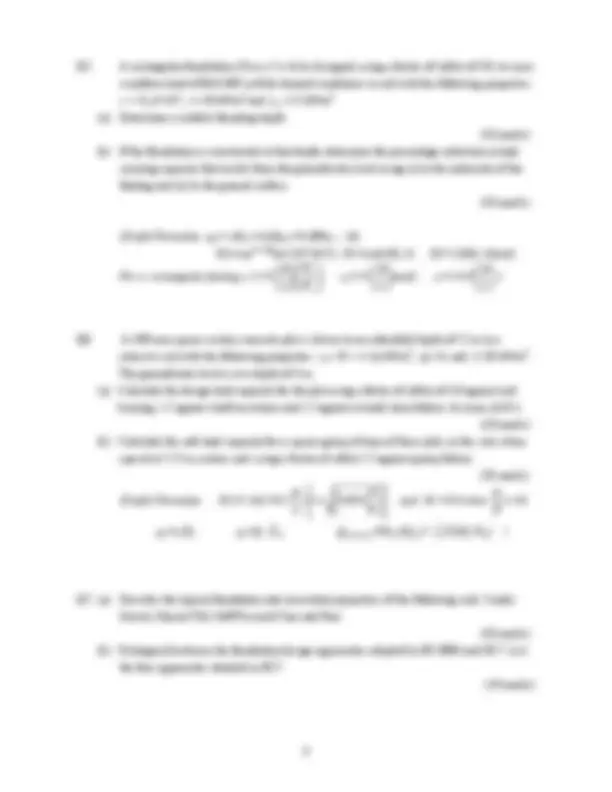



Study with the several resources on Docsity

Earn points by helping other students or get them with a premium plan


Prepare for your exams
Study with the several resources on Docsity

Earn points to download
Earn points by helping other students or get them with a premium plan
Community
Ask the community for help and clear up your study doubts
Discover the best universities in your country according to Docsity users
Free resources
Download our free guides on studying techniques, anxiety management strategies, and thesis advice from Docsity tutors
Main points of this past exam are: Rankine Method, Design Embedment Depth, Soil Properties, Embedment Method, Shear Failure, Fellenius’ Method of Slices, Coefficient of Volume Compressibility, Average Stress Changes
Typology: Exams
1 / 3

This page cannot be seen from the preview
Don't miss anything!


(NFQ Level 8)
Answer five questions Examiners: Mr T Corcoran. Prof. P. O’Donoghue Mr J P Murphy
Q1. (a) A retaining wall with a smooth vertical back supports a 12 m depth of soil. Assume the water table is well below the base of the wall. Using the Rankine method, determine the magnitude and position (height above the base of the wall) of the resultant active thrust on the back of the wall. The soil has the following properties: surface horizontal, no surcharge, two layers, 0-4 m below surface: c ′ = 0; φ′=30°and γ =19.6 kN/m^3 ; below 4 m: c ′= 25 kN/m^2 ; φ′=15°and γ =18.2 kN/m^3. (10 marks) (b) Show that for a wall retaining an unsurcharged horizontal soil surface, using Coulomb’s method, the active thrust is given by: PA = tan( ) cos( ) sin( )
(5 marks) (c) Calculate the active thrust acting on a smooth vertical wall of height 6 m due to a wedge of homogeneous soil (Use a wedge angle of 62°) having an unsurcharged horizontal surface
(5 marks)
Q2. An anchored sheet pile is required to support an excavation of depth 9 m. The anchor will be attached at a point 1.5 m below the ground surface. The water table is well below the toe of the wall. There is no surcharge, wall friction may be ignored and no allowance for
(a) Determine the design embedment depth by the factor of safety on embedment method using Fd = 1.2. (Hint: initial trial depth =4.0 m) (15 marks) (b) Determine the force in the anchor per metre run and the maximum shear force in the sheet pile if F (^) T = 2.0. (5 marks)
Q3. Using Fellenius’ method of slices, determine the factor of safety against shear failure with respect to effective stress for the trial circle shown in Fig Q 3. The pore pressure ratio (ru)
Use 5 slices of equal (4.0 m) width.
Fig Q (20 marks) (Useful formula: F =
W sin
c l tan W(cos ru sec ) )
Q4. The readings shown in Table Q4 below were obtained from an oedometer test on a specimen of saturated clay. The load was held constant for 24 hours before the addition of the next increment. At the end of the last load period the load was removed and the sample allowed to expand for 24 hours, at the end of which time its thickness was 17.92 mm and its water content found to be 31.8%. The specific gravity of the soil was 2.66.
Applied Stress (kN/m^2 ) 0 25 50 100 200 400 800 Thickness (mm) 19.60 19.25 18.98 18.61 18.14 17.68 17. Table Q (a) Plot the e/σ′curve and determine the coefficient of volume compressibility (mv ) for an effective stress range of 220 – 360 kN/m^2. (7 marks) (b) Plot the e/log σ′ curve and from it determine the compressibility index (Cc ) and the preconsolidation pressure σ′pc. (7 marks) (c) Determine the values for consolidation settlement obtained using data from (a) and (b) for a 4 m thick layer of clay when the average stress changes from 220 to 360 kN/m^2. (6 marks)
h
h 0 0
∆ (^1) + ; mv = ( e )
e (^10)
0
1 (^1 )
log( )H ( e )
C (^) c